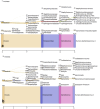Clinical presentation and molecular diagnosis of a possible Mpox virus and Varicella zoster virus co-infection in an adult immunocompetent Filipino: a case report
- PMID: 39639912
- PMCID: PMC11617555
- DOI: 10.3389/fpubh.2024.1387636
Clinical presentation and molecular diagnosis of a possible Mpox virus and Varicella zoster virus co-infection in an adult immunocompetent Filipino: a case report
Abstract
We report the first travel-related case of a possible Mpox-Varicella zoster virus (VZV) co-infection in the Philippines, a country that is endemic for Varicella but non-endemic for Mpox. A 29-year-old Filipino, female, with a travel history to Switzerland and with no prior history of VZV infection sought consultation due to rashes. She presented with multiple papular, pustular, and vesicular skin lesions, some with umbilication and with irregular borders, on the face, neck, trunk, inguinal area, upper extremities, and right leg. She also had bilateral submandibular and post-auricular lymphadenopathies. Tzanck smear exhibited viral cytopathic effects. She tested positive for Mpox infection (Clade II) and Varicella infection via quantitative real-time polymerase chain reaction (qPCR) tests but with a high CT value obtained from the Mpox PCR. Shotgun metagenomic sequencing (mNGS) successfully recovered sequences from the Varicella zoster virus which corroborated with the high viral load detected using qPCR. In contrast, shotgun mNGS was not able to generate a Mpox consensus sequence due to very few reads mapped to the Mpox virus reference sequence, which raised the question if there was the presence of a true Mpox-Varicella co-infection in our patient. Nevertheless, systemic and topical acyclovir was given to the patient. She was discharged and continued home isolation for 30 days from the rash onset. Strategies have been formed by the country's healthcare facilities to properly identify Mpox infection. However, Mpox co-infection with other viral diseases presented a challenge in the proper diagnosis of our patient. This prompted a high index of suspicion and the usage of suitable diagnostic tests. With proper clinical evaluation and utilization of appropriate diagnostic tests, we were able to diagnose the first Filipino patient with a possible Mpox and Varicella zoster virus co-infection.
Keywords: Mpox; Philippines; Varicella zoster; co-infection; rash.
Copyright © 2024 Balingit, Grande, Nicolasora, Polotan, Pantoni, Abulencia, Chu, Rivera, Oblepias and Garcia.
Conflict of interest statement
The authors declare that the research was conducted in the absence of any commercial or financial relationships that could be construed as a potential conflict of interest.
Figures






Similar articles
-
Genomic characterization of the first mpox and varicella-zoster co-infection in Pakistan (2023) through next-generation sequencing.J Med Virol. 2023 Aug;95(8):e29037. doi: 10.1002/jmv.29037. J Med Virol. 2023. PMID: 37587900
-
Case report: A comprehensive report on the first confirmed Mpox case in the Philippines during the 2022 Mpox global outbreak: from clinical presentation to shotgun metagenomic sequencing analysis.Front Med (Lausanne). 2024 Oct 22;11:1387407. doi: 10.3389/fmed.2024.1387407. eCollection 2024. Front Med (Lausanne). 2024. PMID: 39512622 Free PMC article.
-
A co-infection of varicella-zoster virus and Pneumocystis jirovecii in a non-HIV immunocompromised patient: a case report.BMC Infect Dis. 2019 Dec 30;19(1):1092. doi: 10.1186/s12879-019-4715-7. BMC Infect Dis. 2019. PMID: 31888503 Free PMC article.
-
Chronic Headache and Cerebral Venous Sinus Thrombosis Due to Varicella Zoster Virus Infection: A Case Report and Review of the Literature.Am J Case Rep. 2021 Mar 17;22:e927699. doi: 10.12659/AJCR.927699. Am J Case Rep. 2021. PMID: 33727523 Free PMC article. Review.
-
Clinical Features of Varicella-Zoster Virus Infection.Viruses. 2018 Nov 2;10(11):609. doi: 10.3390/v10110609. Viruses. 2018. PMID: 30400213 Free PMC article. Review.
Cited by
-
Detection of mpox and other orthopoxviruses using a lateral flow device as a point-of-care diagnostic.Microbiol Spectr. 2025 Apr;13(4):e0245624. doi: 10.1128/spectrum.02456-24. Epub 2025 Feb 26. Microbiol Spectr. 2025. PMID: 40008874 Free PMC article.
References
-
- CDC . Monkeypox in the U.S. [internet]. Centers for Disease Control and Prevention. (2022) (Accessed Aug 22, 2022). Available at: https://www.cdc.gov/poxvirus/monkeypox/response/2022/world-map.html
Publication types
MeSH terms
LinkOut - more resources
Full Text Sources
Medical

